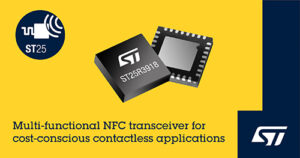The ST25R3918 from STMicroelectronics is a multi-purpose NFC transceiver, supporting passive peer-to-peer functionality, NFC card-emulation mode, and NFC reader operation.
 Delivering most of the functionality of the flagship ST25R3916 NFC reader at a competitive price, the ST25R3918 enables use cases such as accessory identification for a wide range of applications — including power tools and personal healthcare devices where the ST25R3918 interacts seamlessly with ST25 tags.
Delivering most of the functionality of the flagship ST25R3916 NFC reader at a competitive price, the ST25R3918 enables use cases such as accessory identification for a wide range of applications — including power tools and personal healthcare devices where the ST25R3918 interacts seamlessly with ST25 tags.
Its close relationship to the ST25R3916 also simplifies hardware design and certification.
Supporting the NFC-A and NFC-F card emulation, the ST25R3918 can be used as:
- An NFC-A/B (ISO 14443A/B) card reader up to high bit rates
- An NFC-V (ISO 15693) reader up to 53 kbps
- AISO 18092 passive initiator and target
The card emulation mode allows support for the newest features available on mobile phones. End customers can use their phones to interact easily with applications that use the ST25R3918, including using a simple tap to start apps on the phone. Device programming and simple NDEF data transfers are also permitted.
Additionally, users can leverage special stream and transparent modes of the analog front-end (AFE), as well as framing system to implement other custom protocols in card-reader and card-emulation modes.
Combined with the reader mode, the ST25R3918 sports a feature set that allows scanning for tags nearby for tasks, such as replaceable detection and parameter setting, or simply reading an access card. Moreover, the user can interact with the mobile phone while collecting valuable data on customer behavior and accessories used, which adds a stream of information for product development.
With high sensitivity and the added benefit of ST’s noise-suppression receiver (NSR) technology, the ST25R3918 provides an extended and reliable read range and can be operated with output power around 0.5W in noisy and harsh environments.
The ST25R3918 includes a low-power card-detection mode to scan for the presence of a card by measuring the amplitude or phase of the antenna signal. A low-power RC oscillator and wake-up timer automatically reactivates the ST25R3918 after a selected time period to check for the presence of a tag.
Additional features to maximize the performance and value from this transceiver include support for Dynamic Power Output (DPO), which automatically controls the field strength to meet the required limits. On top of this, Active Wave Shaping (AWS) smooths the waveform for better signal integrity.
Filed Under: Applications, Components, News, Wireless


Questions related to this article?
👉Ask and discuss on EDAboard.com and Electro-Tech-Online.com forums.
Tell Us What You Think!!
You must be logged in to post a comment.